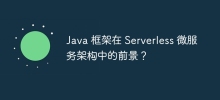current location:Home > Technical Articles > Backend Development
- Direction:
- All web3.0 Backend Development Web Front-end Database Operation and Maintenance Development Tools PHP Framework Daily Programming WeChat Applet Common Problem Other Tech CMS Tutorial Java System Tutorial Computer Tutorials Hardware Tutorial Mobile Tutorial Software Tutorial Mobile Game Tutorial
- Classify:
-

- How does the java framework optimize performance?
- The performance of the Java framework can be optimized by adopting key technologies such as caching, connection pooling, asynchronous processing, distributed architecture, monitoring and analysis. These technologies include: 1. Cache: store frequently accessed data and reduce database access; 2. Connection pool: establish a database connection pool to avoid establishing and destroying connections for each query; 3. Asynchronous processing: transfer time-consuming operations to a separate Threads or asynchronous schedulers to improve concurrency and throughput; 4. Distributed architecture: Split applications into independent services or microservices to achieve scalability and elasticity; 5. Monitoring and analysis: Monitor applications regularly Performance indicators to understand the optimization effect.
- javaTutorial . spring-boot 403 2024-06-01 20:29:00
-

- Debugging Tips for Java Frameworks: Quickly Identify and Fix Errors
- Debugging tips using Java framework: Use breakpoints: pause execution at critical lines of code and check variable values. Use logging: Record key information to track your program's behavior and identify errors. Check exceptions: Capture and print stack traces to understand the code that caused the problem. Use debugging tools: JDB and JVisualVM provide in-depth information about the state of the program.
- javaTutorial . spring-boot 514 2024-06-01 20:25:03
-

- A concise guide to error handling in Java frameworks
- Common mechanisms for Java framework error handling: Exception handling: Use try-catch blocks to catch and handle exceptions. Logging: Log error information for debugging and troubleshooting purposes. HTTP status code: Communicate errors to the client through HTTP status codes.
- javaTutorial . spring-boot 721 2024-06-01 20:19:00
-

- Integration of Kubernetes and Java frameworks
- The Java framework can realize the deployment and management of cloud-native applications by integrating Kubernetes. Integrating Kubernetes with SpringBoot: Adding Kubernetes dependencies Configuring Kubernetes connections Using the Kubernetes client library JHipster Integrating Kubernetes: Generating Kubernetes components Applying Kubernetes deployment settings
- javaTutorial . spring-boot 1139 2024-06-01 20:12:01
-

- The future of Java frameworks in serverless microservice architecture?
- Answer: Java framework is crucial to Serverless microservice architecture, providing high performance, modularity and integration support. Detailed description: High performance and scalability: Frameworks such as SpringBoot and Quarkus provide built-in support for high-performance and scalable microservices. Modularity and loose coupling: The framework supports the decomposition of microservices into maintainable, loosely coupled components. Integrations and Ecosystem: Extensive integrations and third-party libraries simplify connecting to cloud services, databases, and message brokers. Practical example: Serverless microservices built using SpringBoot demonstrate the practical application of using Java frameworks.
- javaTutorial . spring-boot 740 2024-06-01 20:06:12
-

- How does using a Java framework affect developer skill requirements?
- Java framework requirements for developer skills include: Solid Java fundamentals Familiarity with design patterns Framework-specific knowledge (such as Spring) Configuration and deployment skills Debugging and troubleshooting skills In response to these requirements, developers should continue to participate in the community, participate in practices, and seek certifications and training.
- javaTutorial . spring-boot 1120 2024-06-01 20:00:02
-

- Comparison of Java framework and Go framework in the field of cloud computing
- In the field of cloud computing, the Java framework is more suitable for large and complex applications due to its mature ecosystem, dynamics and concurrency support, while the Go framework is more suitable for building microservices and microservices due to its lightweight, scalability and high concurrency. Cloud native applications.
- javaTutorial . spring-boot 579 2024-06-01 19:58:00
-

- How does the Java framework realize the standardization of artificial intelligence components?
- By using a Java framework, such as SpringBoot, we can achieve the following AI component standardization steps: Create a project Integrate TensorFlow Define AI components Use AI components This standardized approach takes advantage of the convenience of SpringBoot to make AI components reusable, scalable, and easy to maintain.
- javaTutorial . spring-boot 540 2024-06-01 19:44:00
-

- Integration of Java frameworks with microservices DevOps practices?
- By combining Java frameworks with microservices and adopting DevOps practices, you can create scalable, easy-to-manage applications and improve the efficiency and quality of your SDLC. Integration methods include: Building CI/CD pipelines to implement automated testing Integrating monitoring tools Automating infrastructure
- javaTutorial . spring-boot 554 2024-06-01 19:39:00
-

- The Way to Optimization: Exploring the Performance Improvement Journey of Java Framework
- The performance of Java frameworks can be improved by implementing caching mechanisms, parallel processing, database optimization, and reducing memory consumption. Caching mechanism: Reduce the number of database or API requests and improve performance. Parallel processing: Utilize multi-core CPUs to execute tasks simultaneously to improve throughput. Database optimization: optimize queries, use indexes, configure connection pools, and improve database performance. Reduce memory consumption: Use lightweight frameworks, avoid leaks, and use analysis tools to reduce memory consumption.
- javaTutorial . spring-boot 724 2024-06-01 19:07:03
-

- How do I choose the best Java framework based on my technology stack?
- How to choose the best Java framework based on technology stack? When choosing a framework for your Java application, it is crucial to consider the technology stack. Here is a guide on how to make the best choice based on your technology stack: 1. SpringBoot is based on SpringFramework and provides an out-of-the-box SpringBean container and lightweight dependency injection. Ideal for small to medium-sized web applications, with built-in servers (such as Tomcat, Jetty) and automatic configuration capabilities. Practical case: Suppose you need to create a simple RESTful API, you can use SpringBootStarterWeb and Sprin
- javaTutorial . spring-boot 634 2024-06-01 19:05:24
-

- Best Practices for Java Microservice Architecture
- Best Java microservices architecture practices: Use microservices frameworks: Provide structures and tools, such as SpringBoot, Quarkus, Micronaut. Adopt RESTfulAPI: Provide a consistent and standardized interface for cross-service communication. Implement a circuit breaker mechanism: gracefully handle service failures and prevent cascading errors. Use distributed tracing: Monitor requests and dependencies across services for easy debugging and troubleshooting. Automated testing: ensure system robustness and reliability, such as using JUnit. Containerization and orchestration: Use tools like Docker and Kubernetes to simplify deployment and management.
- javaTutorial . spring-boot 640 2024-06-01 18:58:04
-

- Performance Impact Assessment of Design Patterns in Java Frameworks
- The performance impact of different design patterns on the Java framework is as follows: Singleton pattern: The object creation speed is slightly improved. Factory pattern: Object creation overhead is high. Proxy mode: Method call times are affected. Observer Pattern: Excellent messaging performance.
- javaTutorial . spring-boot 876 2024-06-01 18:42:00
-

- How does Java framework promote collaboration and knowledge sharing among development teams?
- By providing standardized code structure, unified interfaces, centralized management, documented specifications, community support, and reusable components, the Java framework enhances development team collaboration and knowledge sharing: Standardized code structure: Clear coding conventions facilitate teamwork. Unified interface: allows different modules to interact smoothly and simplifies coordination. Centralized management: Reduce duplicate code and promote collaboration. Documented specifications: Provide in-depth understanding and promote knowledge sharing. Community support: Provide help, discussion and interaction. Reusable components: Facilitating knowledge transfer across teams.
- javaTutorial . spring-boot 1288 2024-06-01 18:37:01
-

- Best practices and common pitfalls of Java frameworks?
- Java Framework Best Practices and Common Pitfalls Using Java frameworks can greatly simplify web development, but it is crucial to follow best practices to avoid common pitfalls. Best Practices: Choose the Right Framework: Choose a framework carefully based on your project needs, considering its functionality, performance, and community support. Use dependency injection: This helps decouple components and facilitate testing. Follow the MVC design pattern: clearly separate views, models, and controllers to improve maintainability. Use RESTful API: Provide standardized and reusable interfaces for interacting with client applications. Implement security measures: Protect applications from attacks such as XSS, CSRF, and SQL injection. Conduct unit testing: verify the correctness of your code and improve your application
- javaTutorial . spring-boot 1103 2024-06-01 17:58:02



































